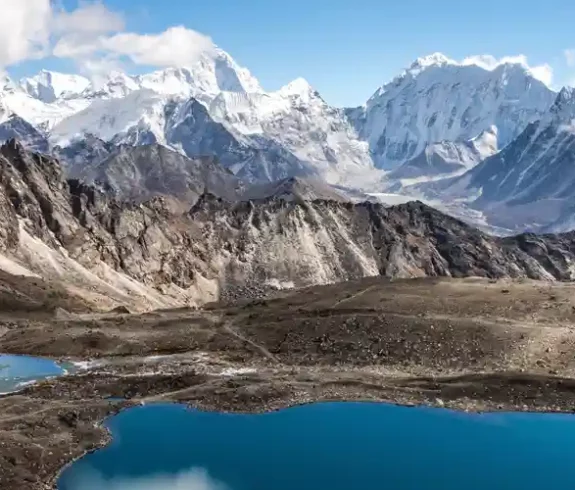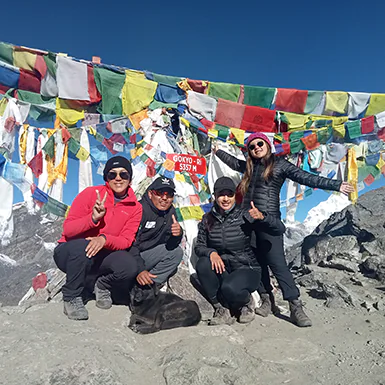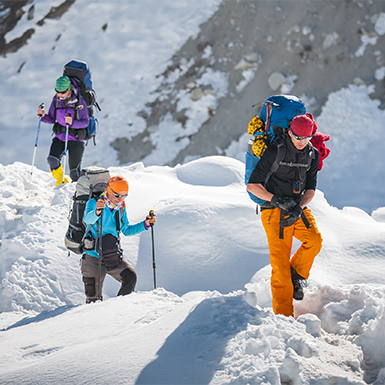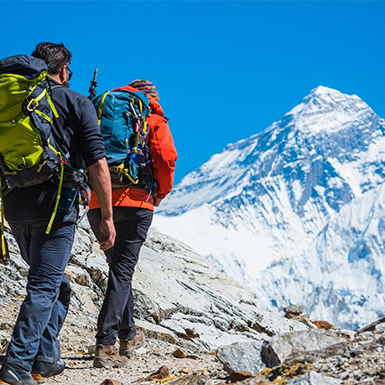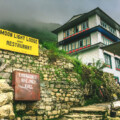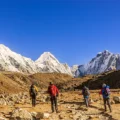Kongma La Pass is a testament to the awe-inspiring power of the Himalayas. This high mountain pass in the Everest region reaches a breathtaking 5,535 meters.
As one of the three high passes in this iconic region, Kongma La Pass beckons adventurers seeking challenges beyond the well-trodden Everest Base Camp trail. Crossing this pass opens up a world of breathtaking scenery and a sense of accomplishment that few other treks can rival.
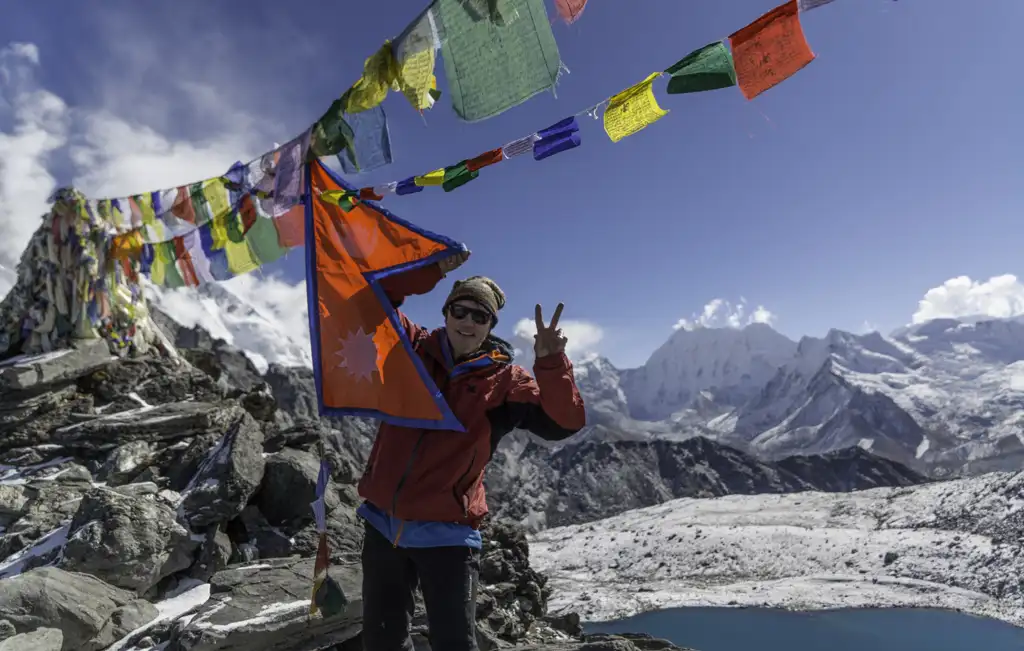
Beyond Everest Base Camp: Embracing the Kongma La Pass Challenge
The allure of Kongma La Pass lies in its ability to transform a standard Everest Base Camp trek into an epic adventure. Trekkers venturing beyond the base camp and navigating this pass receive rewards with:
- Panoramic vistas: From the summit of Kongma La Pass, trekkers enjoy sweeping views of some of the world’s highest peaks, including Everest, Lhotse, Makalu, and Ama Dablam.
- A sense of achievement: Successfully crossing a high pass like Kongma La Pass demands physical and mental fortitude. The feeling of accomplishment upon reaching the summit is unparalleled.
- Remote beauty: The Kongma La Pass trek takes you through less-frequented trails, allowing you to experience the solitude and serenity of the Himalayas.
- Cultural immersion: The route passes through traditional Sherpa villages, offering a glimpse into this mountain community’s unique culture and way of life.
Kongma La Pass: Navigating the Himalayan Crossroads
Nestled amidst the awe-inspiring Everest region, the Kongma La Pass forges a connection between the Imja Valley (home to the village of Chhukung) and the Khumbu Valley (leading towards Lobuche). This high-altitude gateway holds a special allure for adventurers eager to discover the diverse beauty of the Himalayas.
The pass takes center stage in the renowned Three Passes Trek, a challenging circuit encompassing Kongma La, Cho La, and Renjo La. It also frequently extends to the classic Everest Base Camp and Gokyo Lakes treks, enriching the experience for intrepid trekkers.
Reaching the Summit: From Lukla Onward
Your trek to Kongma La commences in the vibrant town of Lukla, the main entry point to the Everest region. From here, well-established trails guide you through picturesque Sherpa villages and breathtaking valleys as you gradually ascend.
Typical Route
- Lukla to Namche Bazaar: This initial leg winds through the scenic Dudh Koshi Valley, facilitating gradual acclimatization.
- Namche Bazaar to Dingboche: The trail meanders through lush rhododendron forests and over suspension bridges, culminating in the village of Dingboche.
- Dingboche to Chhukung: Your ascent continues into the Imja Valley, leading to the high-altitude settlement of Chhukung, the final base before Kongma La.
- Chhukung to the Pass: A challenging climb awaits, culminating in panoramic views from the summit at a breathtaking 5,535 meters (18,159 feet).
- Descent to Lobuche: The path then descends into the Khumbu Valley, arriving at the village of Lobuche. Trekkers can opt to continue towards Everest Base Camp or Gokyo Lakes.
Essential Considerations
- Altitude Awareness: The high elevation of the pass demands careful acclimatization to mitigate the risk of altitude sickness.
- Navigation Aids: A detailed map is invaluable for navigating the trails and pinpointing landmarks.
- Expert Guidance: Due to the demanding nature of the trek, you should strongly consider enlisting the services of an experienced guide and porter for safety and logistical support.
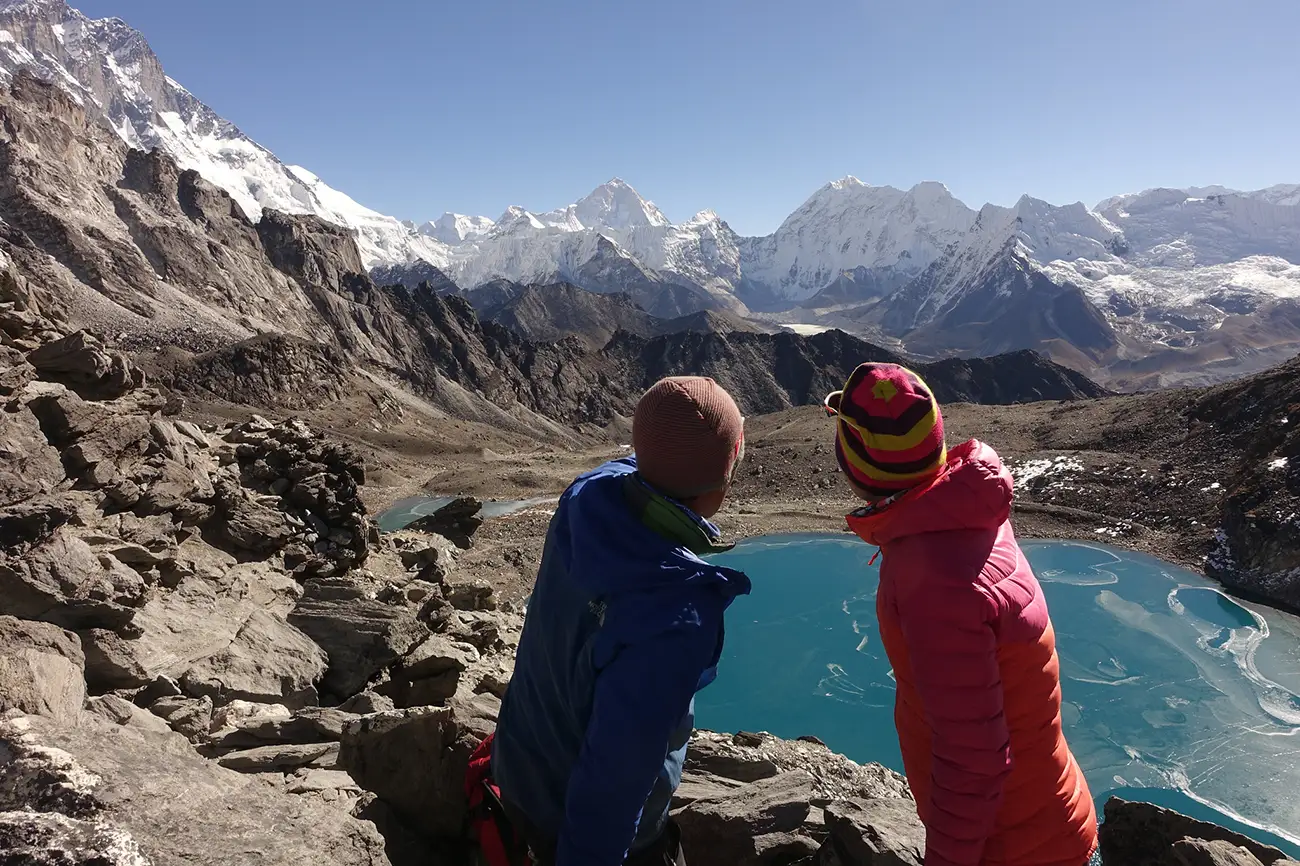
Kongma La Pass Altitude: Scaling the Heights
At a staggering Kongma La Pass altitude of 5,535 meters (18,159 feet), the pass tests the limits of even the most experienced trekkers. The thin air at this elevation can induce altitude sickness, a potentially serious condition with symptoms that range from headaches and nausea to breathing difficulties and confusion.
Acclimatization: Your Pathway to Success
Proper acclimatization is crucial to success when undertaking high-altitude treks like the one to Kongma La. Slowly adjusting to the thinner air can significantly lower your chances of altitude sickness, and enjoy your trek more. Here are essential tips for successful acclimatization:
- Ascend Gradually: Take your time with the climb. Once you’ve reached an altitude of 3,000 meters (9,842 feet), limit your daily ascent to 300-500 meters (984-1640 feet).
- Schedule Rest Days: Plan rest days, especially following substantial altitude increases. It will allow your body the time it needs to adjust.
- Hydration and Nutrition: Drink up! Water and other fluids keep you hydrated. Fuel your activities with carb-filled meals.
- Listen to Your Body: Be mindful of any signs of altitude sickness. If you experience symptoms, descend to a lower altitude immediately.
- Consider Altitude Medication: Talk to your doctor about using altitude medications like acetazolamide (Diamox), which can help prevent and manage altitude sickness.
Trekking to Kongma La: A Test of Will and a Visual Feast
The trek to Kongma La is no walk in the park. It demands both physical fitness and mental fortitude. You’ll navigate rocky, uneven trails and sometimes even challenging moraine paths. The high altitude adds another layer of difficulty, making the trek even more strenuous.
But the rewards are immense. Overcoming these challenges brings an unparalleled sense of accomplishment and leaves you with memories that will last a lifetime.
A Visual Symphony
The scenery along the trek is simply awe-inspiring. As you ascend, the landscape dramatically shifts from lush valleys to the rugged terrain of the high Himalayas.
Reaching the summit at a breathtaking 5,535 meters (18,159 feet) rewards you with a panorama of Himalayan giants. Majestic peaks like Makalu, Lhotse, and Ama Dablam stand proudly, their snow-capped summits reaching towards the heavens. The landscape stretches out in endless, stunning vistas that will leave you speechless.
Highlights of the Journey
- Diverse Landscapes: You’ll encounter a variety of terrains, from verdant valleys to glacial moraines.
- High-Altitude Challenge: Test your limits at 5,535 meters (18,159 feet).
- Panoramic Vistas: Witness awe-inspiring views of Everest, Lhotse, Makalu, and Ama Dablam.
- Cultural Immersion: Trek through traditional Sherpa villages and experience their unique way of life.
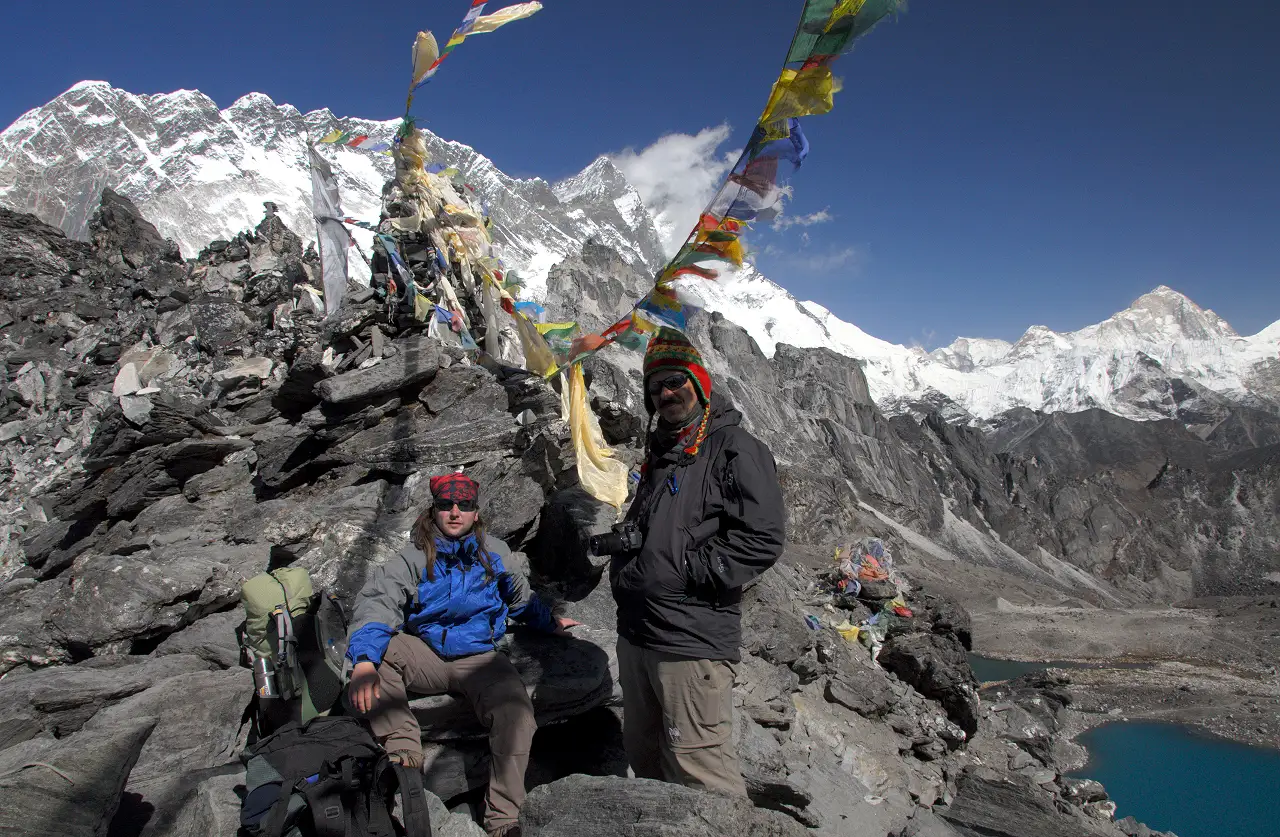
Kongma La Pass: When to Trek for the Best Experience
To experience Kongma La Pass at its finest, plan your trek between March and May or September and November when the weather is most favorable. These seasons give you the most favorable weather, ensuring a safe and enjoyable experience.
- Spring’s Charm: Springtime ushers in warmer temperatures and longer daylight hours. You’ll find the trails free of snow, and vibrant wildflowers paint the valleys with color.
- Autumn’s Allure: After the monsoon rains, autumn delivers crisp air, clear skies, and breathtaking mountain vistas. The trails remain dry and well-defined.
Navigating Seasonal Challenges
- Winter’s Grip (December to February): Winter blankets the region in heavy snowfall and plunges temperatures to freezing levels. Kongma La Pass becomes treacherous with snow and ice, making it off-limits for trekking.
- Monsoon’s Fury (June to August): The monsoon season unleashes heavy rainfall, often triggering landslides and trail closures. Clouds frequently obscure the views.
Weather and Visibility
- Spring and Autumn: These seasons typically boast stable weather with clear skies, offering fantastic visibility for soaking in those panoramic views.
- Winter: Anticipate heavy snowfall and harsh weather, often leading to poor visibility.
- Monsoon: Frequent rain and cloud cover during the monsoon season can limit your mountain views.
Trail Conditions
- Spring and Autumn: The trails are generally dry and well-maintained during these seasons, making your trek more accessible and safer.
- Winter: Snow and ice can transform the trails into slippery hazards, demanding specialized equipment and experience.
- Monsoon: Be cautious after heavy rain as trails become treacherous due to mud and slipperiness, which can lead to falls.
Kongma La Pass Map: Your Guide to Himalayan Heights
The Kongma La Pass map becomes your most reliable guide when tackling the challenging but rewarding trek in the Everest region. It outlines the route, highlights critical landmarks, and helps you estimate distances crucial for planning and navigating your adventure.
Key Points to Locate
Make sure your map displays these essential locations:
- Chhukung: This high-altitude village is your launching pad for the final push to the pass. Ensure your map clearly shows its position relative to other landmarks.
- The pass itself: It’s the star of the show! The map should prominently mark the pass, including its impressive elevation of 5,535 meters (18,159 feet).
- Lobuche: After conquering the pass, your descent leads to Lobuche. Your map should depict the route from the pass to this village.
- Other Landmarks: Look for additional points of interest marked on your map, such as rivers, glaciers, and viewpoints, that can enhance your trek.
Navigating with Confidence
- Get Oriented: Before setting off, take some time to understand your map’s orientation and scale. Locate north and familiarize yourself with the symbols representing various features.
- Monitor Your Progress: Regularly check your map throughout your trek to track your progress. Compare the terrain around you with the map’s details to confirm your location.
- Gauge Distances: Estimating the distances between points using the map’s scale will help you plan your daily itinerary and rest stops.
- Spot Landmarks: Look for critical landmarks indicated on your map, such as prominent peaks, rivers, or unique rock formations. These act as natural navigation aids.
- Embrace Flexibility: Mountain weather can be fickle. If conditions change or unexpected obstacles arise, use your map to evaluate alternative routes or camping spots.
Additional Tips
- Compass for Clarity: A compass is invaluable for verifying your direction, especially when visibility is poor.
- Consult Your Guide: If trekking with a guide, leverage their expertise to interpret the map and navigate effectively.
- Digital Backup: Consider a digital map or GPS device as a backup in case your paper map is lost or damaged.
Essential Preparation and Packing List
Secure Your Permits
Before setting foot on the trail, you’ll need to obtain two essential permits:
- Sagarmatha National Park Entry Permit: This permit grants access to the Everest region, including the Kongma La Pass trek.
- TIMS Card (Trekkers’ Information Management System): This card helps authorities track trekkers and ensure their regional safety.
Get in Shape
- Prioritize Training: The trek to Kongma La demands good physical fitness. Start regular cardio and strength training several months before your adventure.
- Practice with a Pack: Simulate the trek’s conditions by practicing hikes with a weighted backpack.
Pack Smart for High Altitude
- Trekking Poles: These provide stability and alleviate stress on your knees, especially during descents.
- Sturdy Footwear: Invest in durable, waterproof hiking boots with good ankle support.
- Warm Layers: The high altitude means cold temperatures, even in summer—pack layers like a down jacket, fleece, thermal base layers, warm hat, and gloves.
- Waterproof Protection: Wear a waterproof jacket and pants for rain or snow.
- Cozy Sleeping Bag: Choose a warm sleeping bag rated for temperatures well below freezing.
- Sun Protection: The sun’s rays are intense at high altitudes. Shield your skin and eyes with sunscreen and sunglasses.
- Headlamp: A headlamp is crucial for navigating the dark, especially if you plan to start early in the morning.
- First-Aid Essentials: Pack a comprehensive first-aid kit for common trekking ailments, such as blisters, altitude issues, and minor injuries.
- Water Purification: Protect yourself from waterborne illnesses by carrying a water filter or purification tablets.
Finding Rest and Replenishment on the Kongma La Trek: Accommodation and Facilities
Teahouses: Your Cozy Mountain Retreats
Discover a network of welcoming teahouses along the Kongma La Pass trail. These charming, rustic lodges offer essential comforts and serve as crucial rest stops for trekkers. Expect to share dormitory-style rooms with simple beds and blankets, fostering a sense of camaraderie with fellow adventurers.
- Nourishing Meals & Warm Drinks: Teahouses serve hearty meals and steaming beverages, perfect for refueling after a long day on the trail.
- Social Connections: These inviting spaces encourage interaction, allowing you to swap stories and forge new friendships with fellow trekkers.
Lodges: A Touch of Indulgence
In select villages, lodges offer a more luxurious experience than traditional teahouses. These lodges may sometimes boast private rooms, hot showers, and Wi-Fi. While they come at a premium, they provide enhanced comfort and amenities for those seeking more pampering.
Camping: Embrace the Untamed
For a truly immersive experience, consider camping along certain sections of the Kongma La Pass trek. Remember to carry all your camping gear, including a tent, sleeping bag, and cooking supplies.
Essential Facilities En Route
- Food and Water: Teahouses and lodges offer meals and beverages. Bring a reusable bottle and purify your water with tablets or a filter. Safe drinking water might be scarce.
- Rest Stops: The trail features numerous rest stops where you can catch your breath, soak in the views, and recharge before continuing your trek.
- Charging Facilities: While some teahouses and lodges may have limited charging facilities for your electronics, it’s wise to rely on something other than them. Pack a power bank for backup.
- Toilets: Basic toilet facilities are available at most teahouses and lodges along the route.
Kongma La Pass: Where Culture and Nature Converge
Trekking to Kongma La isn’t just about the physical challenge; it’s an opportunity to experience the rich tapestry of Sherpa culture nestled within the Himalayas.
As you trek through the villages leading to the pass, you’ll encounter the warmth and hospitality of the Sherpa people. Engage with the locals, explore ancient monasteries adorned with vibrant prayer flags, and witness the unique customs and rituals that have defined Sherpa life for generations.
- Namche Bazaar: A bustling Sherpa trading hub and gateway to the Everest region, Namche Bazaar offers a window into the local way of life.
- Tengboche Monastery: This revered Buddhist monastery, a spiritual haven amidst the mountains, serves as the heart of Sherpa religious practice.
- Dingboche: This picturesque village invites you to witness traditional Sherpa agriculture and yak herding practices.
Nature’s Masterpiece Unveiled
Prepare to be captivated by the raw, untamed beauty of the Himalayas; the Kongma La Pass trek winds through various landscapes, each more breathtaking than the last.
- Glacial Lakes: Shimmering turquoise lakes, including the iconic Gokyo Lakes, adorn the valleys, where crystal-clear waters capture and reflect the majesty of the surrounding peaks.
- Mountain Majesty: From the pass itself, standing tall at 5,535 meters (18,159 feet), a panorama of Himalayan giants unfolds before you. Majestic peaks like Everest, Lhotse, Makalu, and Ama Dablam dominate the skyline, their snow-capped summits a testament to nature’s grandeur.
- Flourishing Life: The region teems with biodiversity. Vibrant rhododendron forests, rare Himalayan wildflowers, and glimpses of elusive wildlife like musk deer and snow leopards add a touch of magic to your trek.
Safety First: Conquering Kongma La Pass with Confidence
Prioritizing Your Well-being
The Kongma La Pass trek promises breathtaking views and a sense of accomplishment, but remember, trekking at high altitudes demands respect. Prioritizing safety and taking necessary precautions will ensure a rewarding and worry-free experience.
Trekking with a Guide or Group
- Benefit from Expertise: A knowledgeable local guide deeply understands the terrain, weather patterns, and potential risks. They can also offer invaluable assistance in case of emergencies.
- Find Strength in Numbers: Trekking in a group fosters camaraderie and mutual support. You can encourage each other through challenging sections and share the joy of the trek.
Navigating Potential Risks
- Altitude Awareness: Kongma La’s high elevation, reaching 5,535 meters (18,159 feet), increases the risk of altitude sickness. Acclimatize properly, ascend gradually, stay hydrated, and observe your body’s signals. If symptoms arise, descend immediately.
- Weather Preparedness: Mountain weather is notoriously fickle. Pack for sudden temperature drops, strong winds, and precipitation. Layering your clothing and carrying rain gear is essential.
- Tackling Challenging Terrain: The trail to Kongma La Pass includes rocky paths and demanding moraine sections. Ensure your footwear provides excellent ankle support, and use trekking poles for added stability.
- Navigating with Confidence: Fog or snow can obscure the trail, making navigation difficult. Carry a dependable map and compass for your trek, and opt for a GPS as a supplementary navigation aid.
- Physical Readiness: This trek requires a good level of physical fitness. Train in advance and be honest with yourself about your capabilities.
Additional Safety Measures
- Early Starts: Begin your trekking days early to avoid afternoon storms and allow ample time to reach your destination before nightfall.
- Share Your Plans: Inform someone about your itinerary and expected return date, ensuring someone knows your whereabouts.
- Travel Insurance: Ensure your safety by purchasing travel insurance that includes medical and evacuation coverage for your trek.
- Respect the Ecosystem: Practice Leave No Trace principles to minimize your impact on the delicate mountain environment.
Kongma La Pass: A Himalayan Trek Worth Every Step
This high mountain pass embodies the spirit of adventure in the Nepalese Himalayas, offering an experience that transcends the ordinary.
Why Should Kongma La Be Your Next Challenge?
- Conquer the Heights, Reap the Rewards: With its towering altitude of 5,535 meters (18,159 feet), Kongma La Pass will push you to your physical and mental limits. But the panoramic views from the summit reward every ounce of effort.
- A Visual Feast: The trek showcases a tapestry of landscapes, from verdant valleys to stark glaciers, captivating your senses at every turn.
- Cultural Immersion: The trail winds through traditional Sherpa villages, offering a glimpse into their unique culture and warm hospitality.
- Off the Beaten Path: Traversing Kongma La adds an extra layer of adventure to your Everest region trek, taking you beyond the crowds of Everest Base Camp.
